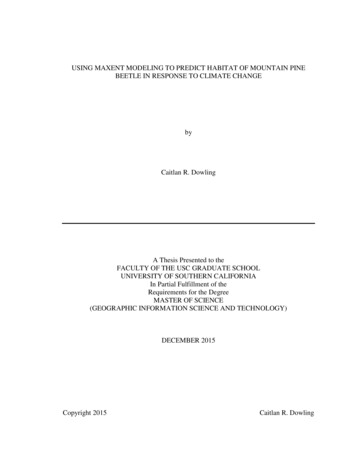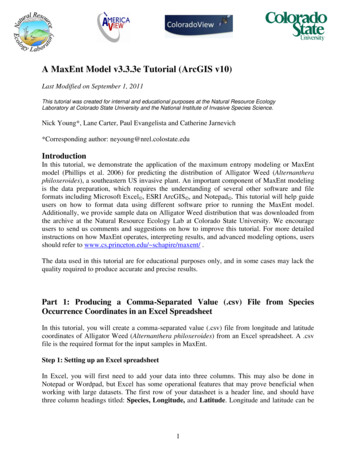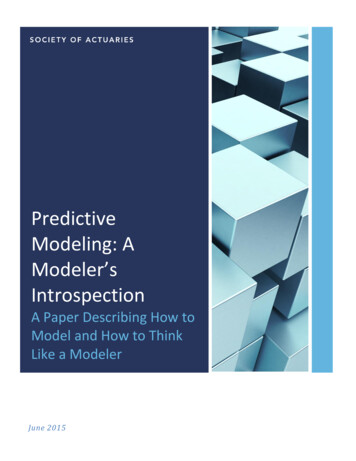
Transcription
USING MAXENT MODELING TO PREDICT HABITAT OF MOUNTAIN PINEBEETLE IN RESPONSE TO CLIMATE CHANGEbyCaitlan R. DowlingA Thesis Presented to theFACULTY OF THE USC GRADUATE SCHOOLUNIVERSITY OF SOUTHERN CALIFORNIAIn Partial Fulfillment of theRequirements for the DegreeMASTER OF SCIENCE(GEOGRAPHIC INFORMATION SCIENCE AND TECHNOLOGY)DECEMBER 2015Copyright 2015Caitlan R. Dowling
ii
ACKNOWLEDGMENTSSo many people have encouraged me throughout this process, from close friend tostrangers on the street. I would like to specifically thank the Spatial Sciences Institutefaculty and staff, including Kate and Ken, and Richard and the GIST Tech Support. Mycommittee Dr. Jennifer Swift and Dr. Darren Ruddell, and my advisor Dr. TravisLongcore. I am lucky to have such a positive advisor- thank you for your direction.Thank you to my parents, who have supported me throughout this process- as they haveall my endeavors- along with the rest of my family. And to my partner, Mark Henspeter,thank you for always reminding me I can do it.iii
TABLE OF CONTENTSACKNOWLEDGMENTS . iiiTABLE OF CONTENTS . ivLIST OF TABLES . viLIST OF FIGURES . viiLIST OF ABBREVIATIONS . ixABSTRACT . xCHAPTER ONE: INTRODUCTION . 11.1 Description of Species . 11.2 Description of Mountain Pine Beetle Habitat . 31.3 Study Area . 71.4 Study . 9CHAPTER TWO: RELATED WORK . 102.2 Vegetation. 122.4 Past Maxent study of the Mountain Pine Beetle . 142.4.1 Biological Data. 142.4.2 Environmental Variables. 142.4.3 Analysis . 162.5 Maxent with CMIP5 . 18CHAPTER THREE: METHODS . 193.2 Research Design . 193.3 Research Data . 203.3.1 Biological Data. 213.3.2 Environmental Variables . 233.4 Procedures . 25CHAPTER FOUR: RESULTS . 274.1 Current Species Distribution Map . 274.2 Future Species Distribution Map . 294.3 Model Performance. 324.3.1 Current . 324.3.2 Future. 324.4 Variable Importance . 33iv
4.4.1 Current . 334.4.2 Future. 34CHAPTER FIVE: DISCUSSION . 365.1 Model Strengths and Weaknesses . 365.2 Geographic Results . 375.3 Current to 2050 and 2070 Changes . 395.4 Variable Results . 425.5 Future Research . 42REFERENCES . 45APPENDICES . 49Appendix A – Jackknife Tests . 49Current . 492050, RCP 4.5 . 502050, RCP 8.5 . 522070 RCP 4.5 . 532070 RCP 8.5 . 55Appendix B – Stretch Maps with 2.5 Standard Deviation . 57Current . 572050 RCP 4.5 . 572050 RCP 8.5 . 58v
LIST OF TABLESTable 1 Safranyik Climate Factors effecting the MPB . 11Table 2 WorldClim Bioclimatic Variables . 15Table 3 Percent Habitat Change . 16Table 4 Square Kilometers . 17Table 5 Square Kilometers deemed suitable . 30Table 6 Percent decrease from current suitable area, 490,075 km2 . 31Table 7 Future AUC Results . 33Table 8 Most Influential Variables . 34vi
LIST OF FIGURESFigure 1 Left, Adult Mountain Pine Beetle; Right, Mountain Pine Beetle Larva(Colorado State University 2011) . 2Figure 2 Forest Service IDS Mountain Pine Beetle Survey Data from 1997 to 2014 . 3Figure 3 Sawdust at the base of a tree is residue from the MPB burrowing into thetree (British Columbia 2013) . 4Figure 4 Lodgepole Pine produce resin in an attempt to keep the beetle out. Whilethis can sometimes be successful, ‘pitching out’ the beetle, often the beetleovercomes the resin and leaves behind pitch tubes (NPS 2011). . 4Figure 5 Study Area . 8Figure 6 2014 MPB Survey Data (Forest Service 2014) . 21Figure 7 The raster grid cells are 30 arc-seconds: 0.008333333333333 degreesor approximately 1 kilometer squared. . 22Figure 8 ArcMap model used to process GeoTIFF images for Maxent . 25Figure 9 Current MPB Suitability (Threshold 0.4666) . 27Figure 10 Current Scaled MPB Suitability . 28Figure 11 Current MPB Suitability compared to MPB Damage from 1997 to 2014 . 29Figure 12 Binary and Scaled Results for 2050 . 30Figure 13 Binary and Scaled Results for 2070 . 31vii
Figure 14 Area Under ROC (Receiver operating characteristic) Curve (AUC),Current Climate . 32Figure 15 These Jackknife results for 2050/RCP 4.5 serve as representativeJackknife results for the future models. Results for each individual modelare available in Appendix B. . 35Figure 16 By 2070, both RCP 4.5 and RCP 8.5 show high suitability for the MPBnear the Great Lakes. Maps showing all results with a 2.5 Standard Deviationare available in Appendix B. . 38Figure 17 The change in suitability for 2050 . 40Figure 18 The change in suitability for 2070 . 41viii
LIST OF ABBREVIATIONSAUCArea Under the ROC CurveGISTGeographic Information Science and TechnologyIDSInsect and Disease Detection SurveyMPBMountain Pine BeetleRCPRepresentative Concentration PathwaysROCReceiver Operating CharacteristicSSISpatial Sciences InstituteUSCUniversity of Southern Californiaix
ABSTRACTThe Mountain Pine Beetle (Dendroctonus ponderosae) is a unique indicator species inthe face of climate change. Since the beginning of this century, it has expanded from itshistoric territory in the Rocky Mountains at an unprecedented rate. As climate variablescontinue to change, it is uncertain how the MPB will spread throughout the continentalUnited States. Existing habitat models have studied the current MPB territory, but havenot yet been expanded to look at how a changing climate might influence the habitablerange for the MPB. In response to recent climate shifts, host tree species have becomeincreasingly susceptible to MPB attack. As their historical habitat is consumed the MPBmay also be expanding into new host species. This study applied Maximum Entropymodeling (Maxent) processes to look at habitat suitability for the Mountain Pine Beetleunder future climate scenarios. Results for two different emissions scenarios for 2050 and2070 both showed a change in the MPB’s range across the United States. Habitable areasbecame more concentrated to cooler areas, typically at higher elevations. These modelsshow that as climate change progresses, the Mountain Pine Beetle will be a dynamicvariable in forest management across the country as it alters not only its distribution, butalso impacted species. Maxent modeling techniques allow a look into the future undervarying scenarios to effectively predict the impacts of climate change on the MountainPine Beetle and its presence in our forest system.x
CHAPTER ONE: INTRODUCTIONThe mountain pine beetle (Dendroctonus ponderosae) (MPB) is a small dark beetle thatburrows into mature pine trees in Western North America. In the twentieth century, MPBhabitat spanned from the Black Hills of South Dakota to the West Coast (Wood 1982).With climate change shifting potential beetle habitat, this study looks at prospective newhabitats for the pine beetle within the continental United States of America. Indetermining what areas could be suitable beetle habitat, forest caretakers can plan for theimpeding beetle arrival and develop an appropriate management strategy. GIS can beused to refine predictions of the areas of U.S. forests at risk from pine beetle infestationunder climate change scenarios.1.1 Description of SpeciesThe MPB is one of many bark beetle species that have been part of a healthyforest cycle for thousands of years. In addition to the fossil record of bark beetlespreserved in tree resin (Nikiforuk 2011, 44 - 45) studies of tree rings in Alaska andCanada show that beetle outbreaks have been a part of a natural cycle to thin forests(Berg et al. 2006, 22). It is hard to view the life cycle of a forest within the life span of ahuman, which makes the MPB seem as a destructive agent. Andrew Delmar Hopkins(1857 – 1948), considered the “father of North American entomology” (Nikiforuk 2011,56) studied the MPB in the late 19th century and deemed it “the enemy of pine forests.”Stephen Lane Wood (1924 – 2009) of Brigham Young University was considered thepremier expert on bark beetles. He authored and co-authored over 100 publications andcategorized over 1000 of the world’s beetles (Cognato and Knizek 2010). In his The1
Bark and Ambrosia Beetles of North and Central America (Coleoptera: Scolytidae): ATaxonomic Monograph, he calls the MPB “the most destructive species ofDendroctonus.”The MPB’s life cycle typically takes one full year to complete. However, incolder climates this cycle can take up to two years to complete, while warmer areas maysee two to three cycles per year (Logan and Bentz 1999, 925). Adult MPBs take flight inearly summer, traveling anywhere from the next tree to over 200 miles to find new treesto infest (Nikiforuk 2011, 73). They then burrow into the tree, eating the phloem of thetree. During this process they also deposit funguses such as the Blue Stain Fungus(grosmannia clavigera) which they carry in their mycangia, or pouches within theircheeks (Halter 2011, 58). After laying their eggs, which develop into larva, the pulpcreated by the fungus then feeds the growing larva into adulthood, in which the cyclestarts again. Adult MPB are 1/8 to 1/3 of an inch, while larva are 1/8 to1/4 of an inch,depicted in Figure 1.Figure 1 Left, Adult Mountain Pine Beetle; Right, Mountain Pine Beetle Larva(Colorado State University 2011)2
1.2 Description of Mountain Pine Beetle HabitatThe MPB is naturally found in the Rocky Mountain region, from the Black Hillsof South Dakota to the west coast (Wood 1982). Figure 2 depicts the span of the MPBrange from 1997 to 2014. The pine (Pinaceae) family represents a range of treessusceptible to the MPB. The MPB predominantly attacks the Lodgepole Pine (Pinuscontorta), typically trees over 10 inches in diameter, 85 to 100 years old. During largeoutbreaks, the MPB will attack trees as small as 4 inches in diameter (Logan and Powell2011). However, they can infest up to 22 different species of pine (Safranyik et al. 2010,416).Figure 2 Forest Service IDS Mountain Pine Beetle Survey Data from 1997 to 20143
Several telltale signs can detect the MPB’s presence in a tree. As MPBs burrowinto a tree, they leave ample sawdust at the base of the tree (Figure 3). Trees with naturaldefenses against the MPB, such as the Lodgepole Pine, produce resin to block additionalbeetles from entering the tree and attempts to suffocate the ones that have already enteredthe tree (Figure 34).Figure 3 Sawdust at the base of a tree is residue from the MPB burrowing into thetree (British Columbia 2013)Figure 4 Lodgepole Pine produce resin in an attempt to keep the beetle out. Whilethis can sometimes be successful, ‘pitching out’ the beetle, often the beetleovercomes the resin and leaves behind pitch tubes (NPS 2011).4
After a successful attack, trees are broken down into three classifications; greenattack (the tree is infested but still photosynthesizing, keeping the needles green), redattack (one year after a successful attack, 90% of all killed trees will have red needles),and gray attack (three years after a successful attack, a tree has lost all of its needles)(Wulder 2005, 18-41). Remote sensing can identify areas of red attack trees. WhileLandsat TM/ETM data can only identify large areas of red attack trees, multispectralIKONOS data can detect small patches of red attack trees due to the pixel size beingapproximately the size of a pine crown (White et al. 2005, 7).Being able to identify small outcroppings of infestation is one of the mostsuccessful forms of preventing further outbreaks, as once an infestation has reached acertain size little can be done to stop it (White et al. 2005, 4). However, remote sensingcan only be used to identify infested trees a full year after an attack has started, as there iscurrently no method to remotely identify green attack trees (Wulder and Dymond 2003,2). This makes accurate prediction models of what areas would be suitable habitat for theMPB important in order for forest managers to be on high alert for the first signs of aMPB attack. Additionally, areas predicted to have a high possibility of a MPB attack cancreate a response plan to implement at the first sign of the MPB.Pine forests naturally maintain a symbiotic relationship with both the MPB andwildfires. The MPB would enter a forest, leaving conditions ripe for forest fires, whichwould clear the underbrush and open the pinecones of old growth Lodgepole Pines(Nikiforuk 2011, 58). America’s stance on wildfire suppression was to extinguish allfires no matter the size or the cause until the 1960s, when a more holistic approach wastaken. It was realized that fire is a necessary part of the forest lifecycle to retain a5
balance between old growth and new growth vegetation. Significant damage had alreadybeen done, and many of the pine forests of North America are full of dense old growthtrees. This has upset the natural relationship between the MPB, trees and wildfires,which historically had worked together to renew forests.The presence of densely packed, old growth pine leaves forests susceptible toboth wildfire and epidemic levels of beetle infestations. The MPB can travel greatdistances to infest a forest, and can spread over thousands of acres in a few short years(Nikiforuk 2011, 73). While an overly dense forest can in itself create a higher firehazard, the presence of the MPB can drastically change the condition of the forest as afuel source (Jenkins 2013, 2). In some cases, if a bark beetle is carrying the blue stainfungus, the dead forest dramatically drops in susceptibility to fire, as seen after the sprucebeetle (Dendroctonus rufipennis) infestation on the Kenai Peninsula, Alaska (Berg et al.2006). This is due to the fungus speeding up the rate of decomposition in the tree,leaving the dead trees soft rather than dry. In other cases, the MPB can leave forests asready fuel for a fire. This is due to the MPB leaving behind dry, brittle trees when thefungus is not present. The relationship grows more complex as firefighters rely onpredicting the movement and severity of a wildfire based on the known vegetationpresent in a forest. Each level of attacked trees, even green attack trees, presents adifferent level of fire susceptibility (Jenkins 2013, 6). This makes the identification ofpotential new MPB outbreak areas highly important for effective fire management,including the safety of surrounding communities and the fire fighters themselves.There is debate over whether the relationship between the blue stain fungus andthe MPB is traditional symbiotic or parasitic on behalf of the fungus. MPBs can6
successfully kill a tree without the presence of the blue stain fungus, and trees can survivewith the fungus (Six 2011, 6-9). However, when trees are already stressed by highertemperatures and lower precipitation their defense system is compromised (Chapman etal. 2012, 2176). This can result in the presence of the fungus increasing their mortalityrate (Halter 2011, 59). MPB larva cannot survive below -40 degrees F, which limits itsavailable habitat (Carroll et al. 2006, 2). In the past 30 years, increasingly fewer areas inNorth America reach this temperature during winter. Longer, warmer summers haveextended the season which adult MPB can emerge from their trees and take flight,attacking new trees. Additionally, a combination of higher temperatures and lowerprecipitation have left trees stressed, increasing their susceptibility to a beetle attack(Carroll et al. 2006, 2).1.3 Study AreaThis study looks at the contiguous United States as potential habitat for the MPB.The data sets used are nation wide data sets, although MPB presence has historicallyappeared in the western United States. The study boundaries (Figure 5) are set by theextent of the rasters used as the environmental variables and future climate variables.These rasters are clipped to the same coordinates NASA NEX uses for their downscaledmodel of the continental United States: -125.02083333, 49.9375, -66.47916667, 24.0625.Moving beyond the immediate boarder of the United States to a slightly largerrectangular prevents error along the borders of the result where the raster results may beskewed.7
Figure 5 Study AreaThis study will look beyond the western United States, as the MPB has recentlybeen identified in Michigan, where it has attacked the Jack Pine (Pinus banksiana)(Klutsch and Erbilgin 2012). Additionally, studies in Canada have modeled how theMPB may move across the boreal forest, which contains significant amounts of Jack Pine(Safranyik et al. 2010.) Study participant Allan Carroll has stated he believes the MPBwould continue to move across the continent (National Geographic 2015.) The Jack Pinedoes not have natural defenses against the MPB such as the Lodgepole Pine. As suitablehabitat shifts, the vegetation the MPB occupies may shift as well. This study will expandthe range typically used to examine MPB habitat to determine if new areas are likely tobecome suitable habitat under climate change scenarios. The western states where theMPB has historically inhabited are also included however, as an increase in temperaturesmay change their habitat boundaries there as well.8
1.4 StudyThe MPB has been the subject of many scientific studies. The literature reviewsection covers the various work that have defined what variables the MPB does or doesnot thrive under, including climate and vegetation. How Maxent can be used as a SpeciesDistribution Model is then explained, along with why the MPB is a good candidate forMaxent. The methods section explains what data will be used for the Maxent Models.The results show the output of the Maxent runs, while the discussion explains themodeling process, the results and their application. This study hopes to answer what areasmay be suitable habitat for the MPB in the future, and the variables that determine this.By using Maxent to create future habitat models, GIS modeling allows for the predictionof suitable habitat into 2050 and 2070.9
CHAPTER TWO: RELATED WORKStarting in the early 2000s, the dramatic outbreak of MPB across the country spurred anincrease in research efforts focusing on the species. These studies are generally composedof two categories; variables affecting the MPB, and how those factors will affect theMPB in the future.2.1 Variables affecting the Mountain Pine BeetleThe Logan et al model looks into how univoltine seasonality (one brood a season)is related to epidemics (Logan and Bentz 1999, 925). The Regniere and Bentz modelstudies at what temperatures MPB larva survive verses succumb to cold temperatures(Regniere and Bentz 2007, 559-72). The Safranyik et al model focuses on a collection ofclimate variables for predicting MPB spread through Lodgepole Pine (Carroll et al. 2006,1). Dr. Les Safranyik and Allan Carroll have been major players in the Canadian ForestService’s research into the MPB. Together they have worked to modify the model, andapply it to predicting range expansion into the Canadian boreal forest (Safranyik et al.2010, 415-442).The Safranyik et al model focuses on identifying areas that are climaticallysuitable for the MPB, considering temperature, length of growing season andprecipitation. For this, they developed a series of true/false statements based off theoriginal model from the 1970s, shown in Table 1.10
Table 1 Safranyik Climate Factors effecting the MPBCriteriaDescriptionRationaleP1 350 degree-days above 5.5 degreeCelsius from August 1st to end ofgrowing season (Boughner 1964) and 833 degree-days from August 1st toJuly 31stA univoltine lifecycle synchronizedwith critical seasonal events isessential for MPB survival (Loganand Powell 2001). 305 degree-days isthe minimum heat requirement frompeak flight to 50% egg hatch, and 833degree-days is the minimum requiredfor a population to be univoltine(adapted from Reid 1962)P2Minimum winter temperatures -40degrees CelsiusUnder-bark temperature at or below 40 degree causes 100% moralitywithin a population (Safranyik andLinton 1998)P3Mean Maximum Augusttemperatures / 18.3 degreesCelsiusThe lower threshold for MPB flight is 18.3 degrees Celsius (McCambridge1971). It is assumed that when thefrequency of maximum dailytemperatures / 18.3 degrees Celsiusis 5% during August, the peak ofMPB emergence and flight will beprotracted and mass attack successreduced.P4Sum of precipitation from April toJune long-term averageSignificant increases in MPBpopulation have been correlated withperiods of two or more consecutiveyears of below-average precipitationover large areas of western Canada)Thomson and Shrimpton 1984)Y1Variability of growing seasonprecipitationSince P4 is defined in terms of adeviation from average, thecoefficient of variation ofprecipitation was included. Itsnumerical values were converted to arelative sale from 0 to 1.Y2Index of water deficit (the index ofwater deficit replaces the waterdeficit approximation (National Atlasof Canada 1970) in the originalmodel of Safranyik et al. (1975).Water deficit affects the resistance oflodgepole pine to MPB, as well assubsequent development and survivalof larvae and associated blue-stainfungi. Water deficit is the yearly sumof (rainfall-evapotranspiration) inmonths with mean air temperature 0)Source: Adapted from Safranyik et al. 2010, 439Although in close proximity to Canada, the contiguous United States possessdifferent climate regions and vegetation types than that of Canada. However, these11
studies developed the variables which subsequent studies have deemed particularlyimportant when studying the MPB. Two dominant factors from the Safrayik et
The Mountain Pine Beetle (Dendroctonus ponderosae) is a unique indicator species in the face of climate change. Since the beginning of this century, it has expanded from its historic territory in the Rocky Mountains at an unprecedented rate. As climate variables continue to change, it is uncertain how the MPB will spread throughout the continental










